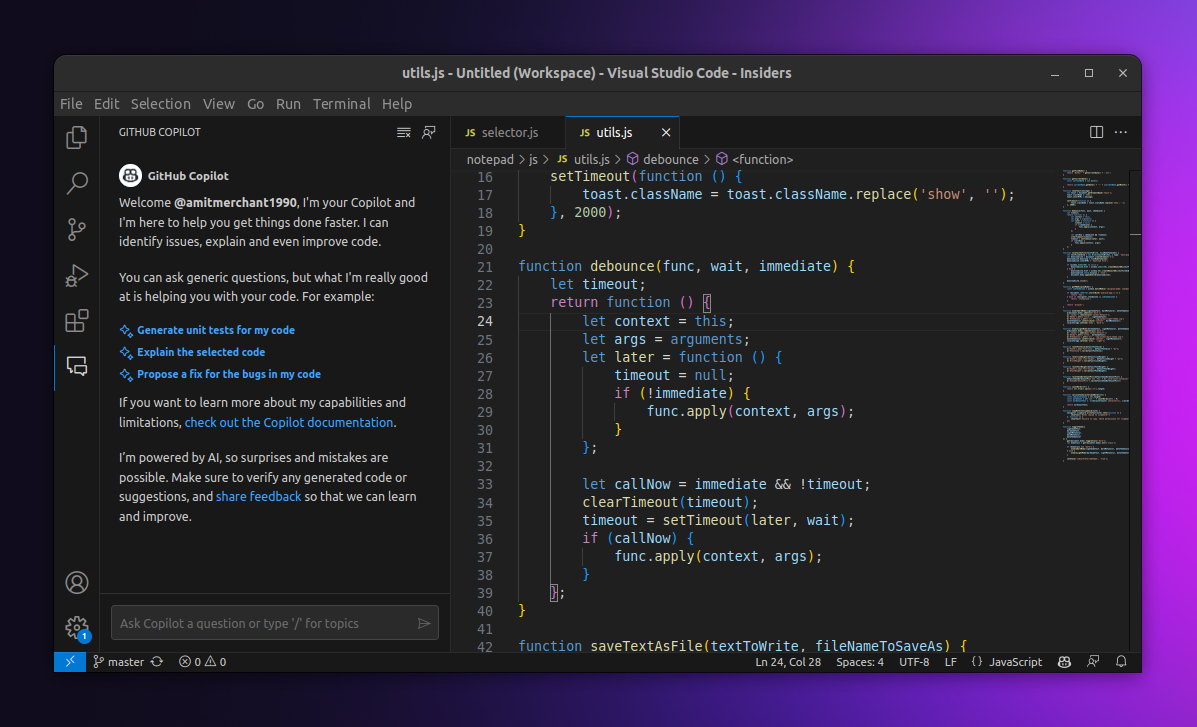
AI-Powered Development Tools
In recent years, Artificial Intelligence (AI) has dramatically influenced nearly every field, and software development is no exception. From enhancing productivity to introducing innovative coding techniques, AI is changing the way developers approach programming. This blog explores how AI is shaping the future of programming, its impact on the industry, and the tools you can use to stay ahead of the curve.One of the most exciting ways AI is changing programming is through AI-powered development tools. These tools assist programmers in a variety of ways, such as code completion, bug detection, and even writing entire functions.
Code Completion and Suggestions

AI algorithms can predict what code a developer is likely to write next. Tools like GitHub Copilot leverage AI to provide suggestions based on millions of lines of code. Copilot, for example, is trained on open-source projects and can suggest entire lines or even functions, saving developers time and effort. You can read more about it here.
Automated Code Reviews
AI also plays a role in automating code reviews, which traditionally require human intervention. With tools like DeepCode, AI analyzes code to provide feedback on potential bugs, security vulnerabilities, and style inconsistencies. This speeds up the process and allows developers to focus on more critical tasks. Explore DeepCode here.
AI not only helps generate code but also ensures that the code is robust, secure, and error-free.
AI for Bug Detection

AI is becoming proficient at identifying bugs that are often missed by human eyes. Tools like Snyk and SonarQube use AI to scan codebases for potential vulnerabilities and suggest fixes. This significantly reduces the time spent on manual testing and ensures higher-quality code. You can learn more about Snyk here and SonarQube here.
AI-Powered Security
AI is particularly valuable in cybersecurity. AI models can detect patterns in code that indicate malicious activity. As cyber threats evolve, AI is increasingly used to develop tools that can automatically patch vulnerabilities and protect against attacks.
AI's influence isn't limited to code generation and security. It’s also reshaping the way software is developed and maintained.
Automated Testing
With AI-powered testing tools, developers can automatically generate test cases based on existing code and requirements. This allows for faster deployment cycles and more reliable software. Tools like Test.ai are helping companies automate app testing with AI-driven tests.
Predictive Development
AI can also be used for predictive development, where machine learning algorithms analyze project data to forecast potential challenges, such as delays, resource allocation, or code quality issues. This helps developers and project managers optimize workflow and avoid setbacks before they happen.
Automated Testing
With AI-powered testing tools, developers can automatically generate test cases based on existing code and requirements. This allows for faster deployment cycles and more reliable software. Tools like Test.ai are helping companies automate app testing with AI-driven tests.
As AI continues to evolve, the possibilities for its application in software development are endless. Developers will increasingly rely on AI for not just coding but also for decision-making, project management, and more. In the future, we may even see AI fully automate the coding process, allowing developers to focus on higher-level design and problem-solving tasks.
---
In 2025, the MERN stack (MongoDB, Express.js, React, and Node.js) continues to dominate the world of web development. As technology evolves, the stack has adapted to new trends, making it a top choice for building full-stack applications. Here's why the MERN stack remains popular and how you can leverage it for your next project.
Current Trends in MERN Stack Development
1.AI Integration: Developers are increasingly incorporating artificial intelligence into MERN applications. For instance, integrating large language models (LLMs) like ChatGPT within React components facilitates real-time content generation and user assistance. MongoDB's vector search capabilities enhance AI-driven search and recommendation systems, while Node.js efficiently runs machine learning models at the edge.COMPILEINFY TECHNOLOGY SOLUTIONS
2.Cloud-Native Solutions: The adoption of cloud-native technologies is on the rise. Serverless MERN applications leverage edge computing, with MongoDB offering serverless instances that scale automatically. React Server Components optimize cloud deployment performance, and multi-region strategies ensure global consistency.COMPILEINFY TECHNOLOGY SOLUTIONS
3.Real-Time Processing and IoT Integration: MERN applications are increasingly handling real-time data and integrating with Internet of Things (IoT) devices. Express.js manages numerous concurrent WebSocket connections, MongoDB's time-series collections optimize IoT data storage, and Node.js workers efficiently process real-time analytics.COMPILEINFY TECHNOLOGY SOLUTIONS
4.Microservices and Serverless Architectures: The shift towards microservices and serverless architectures is evident. MERN's modularity supports the development of scalable and maintainable applications, allowing businesses to respond swiftly to market changes.COMPILEINFY TECHNOLOGY SOLUTIONS
Demand and Career Opportunities
The demand for MERN stack developers remains strong in 2025. The stack's versatility and the growing need for full-stack JavaScript developers contribute to its popularity. Proficiency in MERN technologies opens doors to various career opportunities, including roles such as full-stack developer, front-end developer, back-end developer, and specialized positions focusing on AI integration or cloud solutions.
For those looking to enhance their skills in the MERN stack, several resources are available:
MERN Stack Developer Roadmap 2025: A comprehensive guide outlining the path to proficiency in MERN stack development.TOXIGON
MERN-100-days Roadmap: A structured 100-day plan to master the MERN stack, available on GitHub.GITHUB
MERN Stack 2025 Trends: An article discussing how the MERN stack is driving digital innovation in 2025.COMPILEINFY TECHNOLOGY SOLUTIONS
Trends in MERN Development in 2025
1.Serverless Applications
Tools like AWS Lambda and Vercel Functions integrate seamlessly with Node.js, enabling developers to build scalable serverless applications.
2.GraphQL APIs
While REST APIs are still popular, frameworks like Apollo GraphQL are being paired with Express.js for flexible, query-based data fetching.
3.Microfrontends with React
Microfrontend architecture, combined with React, helps manage large-scale applications efficiently by splitting the UI into smaller, independently deployable modules.
4.Edge Computing
Platforms like Cloudflare Workers and Netlify Edge enhance Node.js applications by running them closer to the user, reducing latency.
Conclusion
As we look to the future, the MERN stack remains a cornerstone of modern web development. Its flexibility, extensive community support, and ability to adapt to emerging trends make it a reliable choice for developers in 2025 and beyond. Whether you're building your first full-stack application or scaling a business-critical system, the MERN stack has the tools to meet your needs.
---
As we look ahead to 2025, the web development landscape continues to evolve at a rapid pace. React and Next.js, two of the most popular tools in the JavaScript ecosystem, have also undergone significant changes. Both have matured, adapted to new trends, and introduced features to meet the demands of modern web development. But with these advancements, the question remains: Which one should you choose for your project in 2025?
React in 2025: Still the King of UI Libraries
React, the JavaScript library for building user interfaces, has maintained its dominance in the frontend ecosystem. By 2025, React has continued to evolve, focusing on performance, developer experience, and adaptability to new paradigms like edge computing and AI-driven interfaces.
Key Advancements in React by 2025
1.React Server Components (RSC): React has fully embraced server-side rendering with React Server Components, allowing developers to build hybrid applications that combine client-side interactivity with server-side efficiency.
2.Improved State Management: With the rise of global state management libraries like Zustand and Recoil, React has made it easier to manage complex state logic without relying on external tools like Redux.
3.Enhanced Developer Tools: React DevTools have become even more powerful, offering better debugging, performance profiling, and AI-assisted code suggestions. Learn more about React DevTools here.
4.Integration with AI: React has integrated seamlessly with AI-powered tools, enabling developers to build smarter, more dynamic user interfaces with minimal effort.
5.Lightweight and Modular: React has become even more lightweight, with tree-shaking and code-splitting becoming more efficient, making it ideal for edge computing and low-latency applications.
When to Use React in 2025
1.When you need full control over your application’s architecture and rendering logic.
2.For highly interactive SPAs or applications that rely heavily on client-side rendering.
3.When building AI-driven interfaces or integrating with edge computing platforms.
4.For projects where flexibility and a rich ecosystem of third-party libraries are critical.
Next.js in 2025: The Full-Stack Powerhouse
Next.js, the React framework developed by Vercel, has solidified its position as the go-to tool for building production-ready, full-stack applications. By 2025, Next.js has expanded its capabilities, making it even more powerful and versatile for modern web development.
Key Advancements in Next.js by 2025
1.Edge Functions and Edge Rendering: Next.js has fully embraced edge computing, allowing developers to run server-side logic and render pages closer to users for ultra-low latency. Learn more about Next.js Edge Functions.
2.AI and ML Integration: Next.js now includes built-in support for AI and machine learning models, making it easier to build intelligent applications with features like personalized content and predictive analytics.
3.Improved Data Fetching: Next.js has introduced new data-fetching strategies, including real-time data synchronization and Incremental Static Regeneration (ISR) for dynamic content.
4.Enhanced Performance: With features like automatic image optimization, font optimization, and smarter caching, Next.js continues to lead in performance out of the box. Check out the Next.js performance docs for more details.
5.Full-Stack Capabilities: Next.js has further simplified backend development with built-in API routes, database integrations, and support for serverless functions.
When to Use Next.js in 2025
When building SEO-friendly, performance-driven applications that require server-side rendering (SSR) or static site generation (SSG), Next.js is the ideal choice. Its built-in support for SSR and SSG ensures that your content is pre-rendered and optimized for search engines, while features like incremental static regeneration (ISR) allow you to update content dynamically without sacrificing performance. Additionally, Next.js excels in creating full-stack applications that seamlessly combine frontend and backend logic within a single framework. With built-in API routes and serverless functions, you can handle backend operations without needing a separate server setup.
Next.js also shines when leveraging edge computing or building real-time, low-latency applications. Its native support for edge functions enables you to run server-side logic closer to your users, reducing latency and improving performance. Furthermore, Next.js has evolved to include built-in support for AI/ML integration, making it easier to build intelligent applications with features like personalized content, predictive analytics, and dynamic user experiences. Whether you're building a content-heavy platform, an e-commerce site, or a real-time application, Next.js provides the tools and optimizations you need to deliver a fast, scalable, and user-friendly experience.
React vs. Next.js in 2025: Key Differences

The choice between React and Next.js in 2025 depends on your project’s requirements and the trends shaping web development. Choose React if you need maximum flexibility and control over your application’s architecture, are building a highly interactive SPA or an AI-driven interface, require edge computing but don’t need the full-stack capabilities of Next.js, or prefer a lightweight, modular approach to building user interfaces. On the other hand, choose Next.js if you’re building a production-ready, full-stack application with server-side rendering or static site generation, need built-in optimizations for performance, SEO, and edge computing, are working on a project involving AI/ML integration or real-time data synchronization, or want a batteries-included framework that simplifies backend development and deployment.
Conclusion
By 2025, both React and Next.js have evolved to meet the demands of modern web development. React remains the go-to choice for building flexible, interactive user interfaces, while Next.js has cemented its position as the ultimate framework for full-stack, performance-driven applications.
When deciding between the two, consider your project’s requirements, your team’s expertise, and the trends shaping the web development landscape. Whether you choose React or Next.js, both tools offer powerful features and a vibrant ecosystem to help you build the next generation of web applications.
What’s your take on React vs. Next.js in 2025? Share your thoughts in the comments below!
